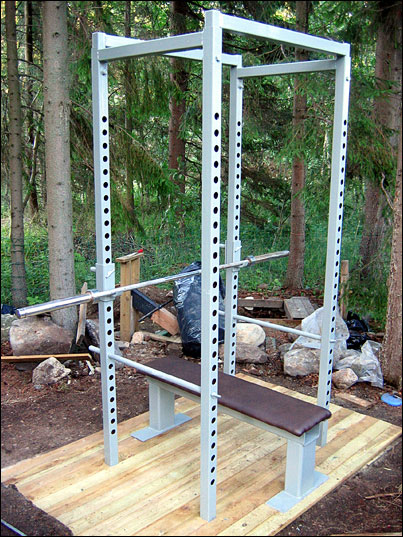Toffe's gym: 1992-1998
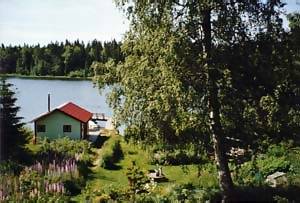
The location: an island outside of Vaasa, Finland
There is no place to spend the summer like our family cottage on an island outside of Vaasa, Finland. When I started weight-training it was only natural that I would start thinking about ways of bringing the holy pump with me. Push-ups and bodyweights squats for three months? No way!
History: From stones to Olympic plates
In the beginning (1992) it was a veritable Flintstones gym, equipped only with carefully measured stones with their weight painted on them in yellow. These stones, weighing from 0.5 kg to 10 kg each, could be loaded into a basket on my primitive cable machine. The cable was only a string than ran through an upper and lower swivel attached to bars nailed between two trees. After I snapped the cord trying to do close-grip pulldowns with 31 kg worth of stone it was relegated to one-handed pushdowns and various forms of delt flyes. My stone age gym also had dip bars and a pull-up bar placed between two trees, plus the obligatory home-made push-up bars.
The next summer (1993) weights entered the island in the form of a standard 50 kg vinyl coated barbell set reinforced with some extra iron plates borrowed from my home gym. I also built a bench out of wood (see below) to enable different forms of chest work.
In 1993, I finally added legs to my workout, something I had avoided since I felt it would hamper my martial arts training. Returning to the island the next summer (1994), in the company of some extra plates, I immediately built myself a squat rack between two trees. In the autumn I left to serve a compulsory 11 months in the Finnish army, making the summer of 1995 a rather uneventful time in the evolution of Toffe's Gym.
In 1996 my strength had evolved to the level were I needed more weights again. The vinyl barbell set and extra iron plates were now relegated to dumbell weights as I bought an 180 kg Olympic barbell set. Since the platform of my old squat rack had started to rot (the wood being untreated) and was unnecessarily narrow for an Olympic bar, a new wide squat rack was called for. I also built a donkey calf machine and a seated calf press.
The gym as it looked in 1998
In 1998, when these pictures were snapped, the gym looked essentially like it did after the major changes of 1996. Like the surrounding trees, the gym is very much alive and keeps changing to reflect my wants and training needs. Click the images for larger versions.
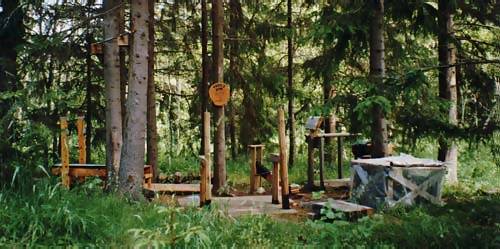
Gym overview.
Equipment from left to right: bench, pull-up bar, squat rack, donkey calf
machine, platform used for stiff-legged deadlifts, combined preacher curl and
dip station, seated calf press (only partially visible) and a weight shed.
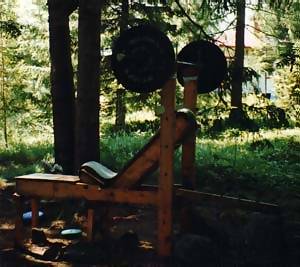 Like everything else in the gym, the
bench is also made of wood. The basic design and proportions were patterned on
a Weider Cobra bench I had at home; a back rest that can be moved from flat to
incline by sticking a pin through the uprights and static uprights with several
bar holders (much sturdier and nicer than other benches were one had to adjust
the uprights). To it I added an adjustable seat (same idea, just lift it up and
push a pin throught holes in the bench) to create a better position for incline
work. I also made the bench much longer to allow me to keep the feet on the
bench and added a separate support to get the bench to a completely upright position
(mainly for shoulder presses and curls). The bar holders are
reinforced with heavy steel rods running through them.
Like everything else in the gym, the
bench is also made of wood. The basic design and proportions were patterned on
a Weider Cobra bench I had at home; a back rest that can be moved from flat to
incline by sticking a pin through the uprights and static uprights with several
bar holders (much sturdier and nicer than other benches were one had to adjust
the uprights). To it I added an adjustable seat (same idea, just lift it up and
push a pin throught holes in the bench) to create a better position for incline
work. I also made the bench much longer to allow me to keep the feet on the
bench and added a separate support to get the bench to a completely upright position
(mainly for shoulder presses and curls). The bar holders are
reinforced with heavy steel rods running through them.
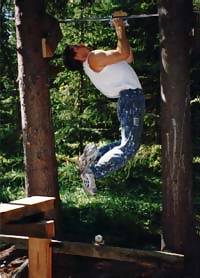 A very slimmed down me demonstrating
close-grip pull-ups. The V-bar handle has been padded with wood to make it fit the
bar better and keep it from sliding so easily. My preference has always been to
arch in under the bar trying to pull the handle to the stomach. The pull-up bar
is simply a normal bar that is placed in jacks in support beams nailed straight
into the tree trunk. The lower beam still holds a swivel that belonged to the
original cable machine mentioned above.
A very slimmed down me demonstrating
close-grip pull-ups. The V-bar handle has been padded with wood to make it fit the
bar better and keep it from sliding so easily. My preference has always been to
arch in under the bar trying to pull the handle to the stomach. The pull-up bar
is simply a normal bar that is placed in jacks in support beams nailed straight
into the tree trunk. The lower beam still holds a swivel that belonged to the
original cable machine mentioned above.
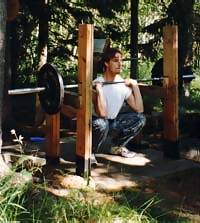 The most useful piece of equipment after
the weights themselves: my squat rack. This is where I did my first 100 kg
full-squat for 2 reps and my first 150 kg deadlift during the summer of 1996
when I tried a powerlifting routine for a couple of months. The platform was
made big enough to allow for deadlifts behind the rack, plus there are a couple
of very sturdy metal pins at the back of the beams where the bar can be placed
for heavy shrugs. If you look closely at the support beams you can see that
they have been lowered; almost immediately after I finished the rack with
support beams placed just below parallel I decided to start going
rock-bottom.
The most useful piece of equipment after
the weights themselves: my squat rack. This is where I did my first 100 kg
full-squat for 2 reps and my first 150 kg deadlift during the summer of 1996
when I tried a powerlifting routine for a couple of months. The platform was
made big enough to allow for deadlifts behind the rack, plus there are a couple
of very sturdy metal pins at the back of the beams where the bar can be placed
for heavy shrugs. If you look closely at the support beams you can see that
they have been lowered; almost immediately after I finished the rack with
support beams placed just below parallel I decided to start going
rock-bottom.
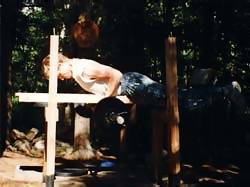 My favorite
rowing exercise: lying barbell rows. Saves the back and allows one to
concentrate on nothing else but blasting the bar up. Easy to set up by just
placing a thick board over the squat rack. Here demonstrated with a
reverse-grip, which happens to be my favorite.
My favorite
rowing exercise: lying barbell rows. Saves the back and allows one to
concentrate on nothing else but blasting the bar up. Easy to set up by just
placing a thick board over the squat rack. Here demonstrated with a
reverse-grip, which happens to be my favorite.
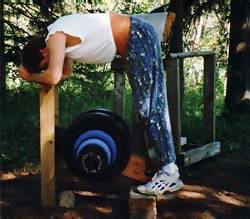 Donkey
calf raises rule. The only problem is that I can only get about three plates
(60 kg) to fit between my legs using a dip belt. On this thing I've had 280 kg
(the machine itself can take about 195 kg with the plates I have now, then you
just need to find someone to sit on your back). Simple to build: just one lever,
pins for plates and a hole at the tip where a dip belt can be
fastened. Best calf machine I've ever tried. Could easily be made out of steel as well.
Donkey
calf raises rule. The only problem is that I can only get about three plates
(60 kg) to fit between my legs using a dip belt. On this thing I've had 280 kg
(the machine itself can take about 195 kg with the plates I have now, then you
just need to find someone to sit on your back). Simple to build: just one lever,
pins for plates and a hole at the tip where a dip belt can be
fastened. Best calf machine I've ever tried. Could easily be made out of steel as well.
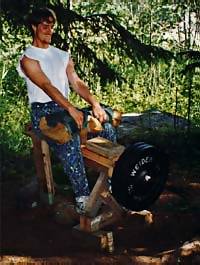 It works
better than it looks; a wooden replica of the standard calf raise machine.
Originally made to hold stones on top in a basket, since modified for
plates.
It works
better than it looks; a wooden replica of the standard calf raise machine.
Originally made to hold stones on top in a basket, since modified for
plates.
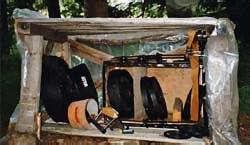 Weight shed that protects
the plates from the forces of nature. Contains 160 kg of plates, dip belt,
modified V-bar used for pull-ups, straps, mosquito repellant (you need that
after the sun goes down in this neighbourhood), handles used as dumbells and
spring collars. Since the plastic coated barbell set doesn't mind water it
usually lives under the bare sky. Not that I need it for much anything
anymore.
Weight shed that protects
the plates from the forces of nature. Contains 160 kg of plates, dip belt,
modified V-bar used for pull-ups, straps, mosquito repellant (you need that
after the sun goes down in this neighbourhood), handles used as dumbells and
spring collars. Since the plastic coated barbell set doesn't mind water it
usually lives under the bare sky. Not that I need it for much anything
anymore.
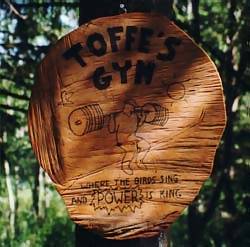 The finishing touch. You
might notice that the squatter is strangely upright considering the amount of
plates he is moving; the reason is that I traced the general contour from a
picture of a guy squatting in a Smith.
The finishing touch. You
might notice that the squatter is strangely upright considering the amount of
plates he is moving; the reason is that I traced the general contour from a
picture of a guy squatting in a Smith.
If you have an outdoor gym or get inspired to build your own, don't hesitate to send pictures or get in touch.
Postscript (22 August 2005)
